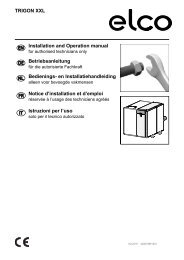Nimbus Compact M NET R32 Installation Manual UK
Create successful ePaper yourself
Turn your PDF publications into a flip-book with our unique Google optimized e-Paper software.
Service<br />
User information<br />
Inform the user on how to operate the installed system.<br />
In particular, hand this instruction manual to the users, informing<br />
them that is must be kept near the product at all times.<br />
Inform potential users that the following actions must be carried<br />
out:<br />
– Periodically check the system water pressure.<br />
– Restore system pressure, by deaerating the system<br />
when necessary.<br />
– Adjust the setting parameters and the adjustment devices<br />
to optimise operation and reduce the system’s<br />
operating costs.<br />
– Perform regular maintenance, as envisaged in the<br />
standards.<br />
Anti-freeze function of the indoor unit<br />
The primary circulation pump of the indoor unit starts at maximum<br />
power when the temperature measured by the “CH<br />
Flow” sensor falls below 7°C in heating mode.<br />
The primary circulation pump stops when the temperature<br />
measured by the “CH Flow” sensor rises above 9°C in heating<br />
mode.<br />
a<br />
The integrated heating elements must never<br />
be disconnected electrically from the terminal<br />
board.<br />
Anti-freeze function of the outdoor unit<br />
The primary circulation pump of the outdoor unit starts at the<br />
minimum speed when the water delivery temperature (LWT)<br />
is below 10°C or the return temperature (EWT) is below 7°C in<br />
heating mode. It will instead start if the delivery temperature<br />
(LWT) is less than 1°C in cooling mode.<br />
The primary circulation pump stops at when the delivery temperature<br />
(LWT) is below 10°C or the return temperature (EWT)<br />
is above 8°C in heating mode. It will instead stop if the delivery<br />
temperature (LWT) is above 4°C in cooling mode.<br />
If the LWT sensor malfunctions, the protection logic will be<br />
based on the values measured by the outdoor temperature<br />
sensor (OAT) of the outdoor unit. The primary circulation pump<br />
starts when the external temperature sensor gives a reading<br />
below 7°C in heating mode. The primary circulation pump<br />
stops after 30 sec or when the external temperature sensor<br />
gives a reading above 8°C in heating mode. This check is repeated<br />
every 15 minutes.<br />
a<br />
Once maintenance operations have been completed,<br />
mount all previously removed components<br />
back on again and secure them adequately.<br />
7.1 Cleaning and inspecting the indoor unit<br />
It is necessary to carry out the following checks at least once<br />
a year:<br />
– Inspection of the hydraulic system for filling and tightness,<br />
and replacement of seals, if necessary.<br />
– Presence of air bubbles in the water supply distribution<br />
network.<br />
– Check to verify the operation of the heating safety system<br />
(limit thermostat check).<br />
– Check the heating circuit pressure.<br />
– Inspection of the expansion vessel pressure.<br />
a<br />
Do NOT replace burnt fuses with fuses of different<br />
amperage, as this may damage the circuit or<br />
trigger a fire.<br />
Only use a soft and dry cloth to clean the unit.<br />
If the unit is very dirty, it is possible to use a cloth dampened<br />
with lukewarm water.<br />
Check that the drainage pipe is laid according to the instructions.<br />
If not, water leakages may occur resulting in material<br />
damages and the risk of fire and electrocution.<br />
7.2 Cleaning and inspecting the outdoor unit<br />
It is necessary to carry out the following at least once a year:<br />
– Inspection of the refrigerant gas seal.<br />
– Cleaning of the front grille.<br />
Only use a soft and dry cloth to clean the unit.<br />
If the unit is very dirty, it is possible to use a cloth dampened<br />
with lukewarm water.<br />
If the evaporator (1) of the outdoor unit is clogged up, remove<br />
all leaves and debris, then clean off all dust from inside to outside<br />
with compressed air jet or some water. Repeat the same<br />
procedure with the front grille (2).<br />
1 2<br />
Fig. 94<br />
74 / EN

















